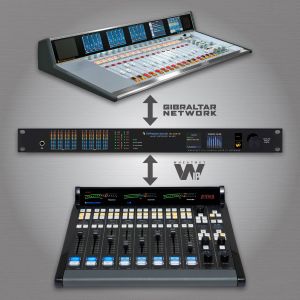 The lights are always on at Entravision in Los Angeles.
The lights are always on at Entravision in Los Angeles.
There’s no downtime on the third floor at 5700 Wilshire Blvd., where so much of Entravision’s programing is originated for its 37 FMs and 11 AMs in the U.S., including eight stations in the Los Angeles area.
It’s the kind of thing that can keep an audio network manufacturer up at night, knowing as we do that all 30 studios here are routed by the Wheatstone TDM system and controlled by Wheatstone consoles.
But over the years, we’ve become rather comfortable with the idea that our systems are, in a roundabout sort of way, running the show here.
Then, a few months ago, Jay Tyler got the call. (No, not that one – the Wheatstone gear continues to be the workhorse it’s always been.) Rick Hunt, Entravision’s Vice President of Engineering – Western Region, called to inquire about adding onto Old Reliable and wanted to know what we thought about integrating IP audio networking into the facility.
We’d been ready for this day for some time. MADI, as many of our customers know, is a well-established AES standard that is used in pro audio and elsewhere for transporting up to 64 channels of uncompressed digital audio (at 48kHz sample rate) over one cable. It’s also a great go-between for systems that use different native formats.
We have a MADI interface that can make the jump between our TDM and IP audio networks and we’ve been told by our customers that interfacing between the two is relatively seamless.
But, why mess with a good thing?
Because, as Rick recognized, IP has advantages that TDM doesn’t, among them cost savings and the ability to interface consoles and other gear more directly into the group’s ENCO automation system. The group’s TDM system used soundcards to get AES audio into the automation system, whereas its new WheatNet-IP directly passes audio into the automation using software drivers.
Plus, now that IP audio networking has been around for almost two decades, it has proven to be reliable technology.
By adding a MADI BLADE between the two, Entravision can have the best of all worlds – keep its reliable TDM network and add on any new studios using IP audio networking.
Entravision started down the path of IP audio networking last month with a new image studio that uses a Wheatstone L-8 control surface, which is the perfect size (8 faders with bus-minus (N-1) on each, four stereo busses, headphone amp, and just-right meter bridge) for producing liners, cut-ins, IDs and jingles. The L-8 interfaces to a network of six WheatNet-IP I/O BLADEs, or access units, including a MADI BLADE interface to the TDM network.
The MADI BLADE provides up to 64 channels of audio (AES 10) between the new WheatNet-IP audio network and Entravision’s existing TDM router network.
The new studio is up and running and the best part is, we can still get a good night’s sleep knowing that things are humming along at Entravision as usual.

